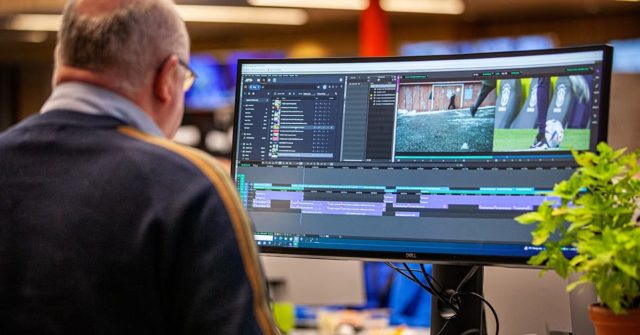Sveriges Television (SVT), Sweden’s national public broadcaster, is based in Stockholm and controls four national channels that broadcast a variety of programs, including news, sports, entertainment, children’s shows, arts, and culture. The network produces about 2000 hours of original HD content annually.
Over the past few years, SVT has been steadily moving toward a centralized virtual news production platform to increase efficiency in the production process, save money, and improve collaboration between team members, no matter where they are.
As a longtime user of Avid video and audio technologies, SVT turned to Avid to help them enable remote work and content sharing across a variety of production processes, ensure that content was stored and accessed safely and securely, and be able to upload materials once rather than multiple times.
“Avid offers the security and stability we need. We work almost 24 hours a day, seven days a week, 365 days a year, and we can’t afford to have the system down,” says Olof Appelqvist, SVT’s Head of Post Production.

SVT currently owns an end-to-end news production solution based on the Avid Media Central production management platform. Systems, files, projects, and media can be used throughout the system by anyone who has access to it. Media Central Cloud UX allows team members to access content over the Internet with very low latency, eliminating dependence on physical infrastructure. Journalists, producers, editors, directors, and others can collaborate from anywhere, adding, recording, editing, and approving content no matter where they are: in the field, at home, or in the company office. The amount of time required to publish news on the air and on social media platforms is significantly reduced, as fewer files need to be moved from one workstation to another.
“Having access to and control over all of our communication channels is critical when you work with so many employees around the world,” explains Anders Vallin, SVT. “We need very tight control over who can access what, and Media Central gives us that.”
The financial benefits are also significant. Since the company can quickly scale up or down production depending on the workload, it only spends the resources it needs at the time. “At the moment, we are working in ways we could not have even imagined two years ago,” says Wallin.
Opening up new opportunities through remote access
At first, the company was guided only by the challenges of the COVID pandemic, but now remote work has become part of its production approach.
SVT took a cautious approach to the transition to the new infrastructure, initially adding a small number of virtualized Avid Media Composer workstations.
When the remote processes were launched, SVT executives began to realize their benefits. For example, in the past, media files had to be copied over a VPN or to a physical disk to allow access by multiple team members. Today it is available for editing and instant approval via the cloud.
“We used to need people to actually move the hardware and run new cables,” Wallin says. “Now you can have a content processing session in our private cloud. We don’t move the media, we move the interfaces, and you can work from anywhere on the sequences. We can actually work differently and more economically.”
SVT editors and journalists quickly adapted to this new way of working. One of SVT’s night shift editors works in Australia but covers Swedish national news. He now creates small stories overnight by accessing content and adding voiceover through Media Central | Cloud UX, and then uses a virtualized Media Composer for editing. Using time zones to his advantage, his finished stories are broadcast on SVT’s morning news.
“Editors can bring their work home and it doesn’t matter because the environment they enter is exactly the same as on a work computer,” says Appelquist. “They don’t have big monitors or speakers, but they can get all the content they need very quickly.”
Easier collaboration with third-party vendors
Working with third-party vendors is a creative freedom that SVT gives its editors, and the openness of the platform facilitates interaction between systems. Previously, editors had to copy and export media files so that they could import them to another platform. This process was inefficient, fraught with security issues, and prone to errors. “The new platform has really been a game changer for us because, for the first time in years, we feel like we have control over the production processes that were outside, especially when it comes to cloud-based media sharing and publishing platforms,” explains Wallin.
Another result of the new production processes is that SVT can produce more customized content to meet the growing demand for information on different broadcast platforms. The company was able to increase the number of hours of content produced. “The show has doubled from eight episodes to 16, and we now have an efficient production process from camera to editing station because we have no problem scaling up,” says Appelquist.
Data security
One of the biggest advantages of the updated SVT production platform is the security of content storage and access. SVT chose to operate in a private cloud rather than a public cloud to preserve the integrity of its investigative journalists’ work. “It’s a stable, secure system that can handle a heavy workload,” Appelquist comments. “People trust us as a public broadcaster to provide confidential information. We cannot risk leaking materials.”
SVT’s media storage is also secure. All editors are directly connected to Avid NEXIS shared media storage via LAN, optical, or Ethernet. “We know that our content is secure, which allows us to look forward with confidence,” says Wallin. “We can focus on what really matters, be more efficient and create more content.”
The Appelquist team has big plans for how to maximize the use of their new tools. They are looking forward to introducing additional features, including artificial intelligence (AI) and metadata, to the MediaCentral | Cloud UX platform. “We’ll be able to import more metadata to speed up the search for the material we need instead of wasting time browsing through the materials,” Wallin says. AI also automates some routine production processes.
Based on the materials of AVID
https://www.avid.com/customer-stories/SVT-Customer-Story?utm_source=marketo&utm_medium=email&utm_campaign=23-all-np-media_matters_newsletter–land&utm_content=dnaor,05DD2023,global,may2023&mkt_tok=NDg2LUVWVS01NTkAAAGLo8SJlz8UaLRUckvy5T8NkpVMrtJSdYQ5dUZhPJnidXMc5hsdq4uY25CDgEdsftB-qEw5_W15_hubXAwEKz4

